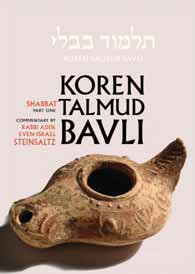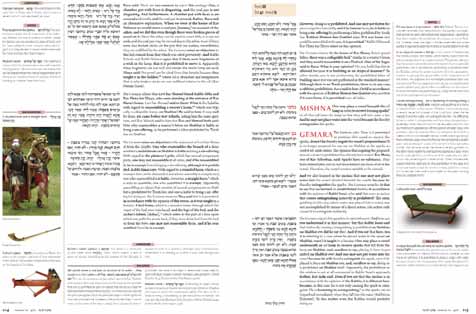First Impressions of the Koren Talmud
 Koren Talmud Bavli
Koren Talmud Bavli
By Adin Even-Israel Steinsaltz
Koren Publishers
Jerusalem, 2012
Reviewed by Harvey Belovski
A long-standing Daf Yomi devotee, I have become familiar with certain learning tools. These include pocket Agudah publications, the ArtScroll Schottenstein Talmud, the older Soncino translation, my favorite, Metivta, a colossal Hebrew-language scholarly work and, more recently, the ArtScroll Talmud App. At first glance, the market appears saturated, but the Koren Talmud Bavli, which recently won the National Jewish Book Award in the Modern Jewish Thought and Experience category, offers a perspective and learning experience genuinely different from existing resources.
Koren Publishers is well known for its imaginative approach, textual precision and stylistic excellence. Its Tanach and liturgical offerings, which include the recent Sacks Siddur and machzorim, have been hailed as paragons of design and presentation. Koren’s unmistakable Hebrew typefaces are easy to read, and powerfully amalgamate the gravitas of ancient texts with modern aesthetic sensitivities. Unparalleled in the world of Jewish publishing, these trademark accomplishments have now been harnessed to the outstanding genius of Rabbi Adin Even-Israel Steinsaltz, the world’s best-known teacher and translator of the Talmud, to produce an extraordinary new edition of the Babylonian Talmud. Rabbi Steinsaltz is famous for having published the entire Talmud reformatted with Modern Hebrew translation and elucidations, known for their scholarship and accessibility. This new edition is based on that earlier work. A formidable editorial and translation team is headed by Rabbi Dr. Tzvi Hersh Weinreb, executive vice president, emeritus of the Orthodox Union, and complemented by luminaries such as Rabbi Dr. Shalom Berger and my contemporary from Oxford, Rabbi Jason Rappoport, formerly of Yale University, to name but two.
The volumes, of which two—Berakhot and Shabbat, vol. 1—of a projected forty-one, had been released at the time of this writing, are beautifully presented. (There are actually several editions: a $50 standard model with color photographs and a smaller, $40 monochrome Daf Yomi version, as well as various online PDF options and a proposed app; the publisher furnished me with the two available volumes in the color edition). The boldest formatting decision is obvious immediately, as the tzurat hadaf—regular Vilna format of the Talmudic text—is present, but has been completely separated from the translation and annotations, the section which most readers will use. Opening a volume from the “Hebrew” side, one encounters the standard Hebrew/Aramaic folios (although, unlike in most editions, including Soncino and ArtScroll, the text includes diacritics and punctuation); from the “English” side, the new translation and commentary appear, following approbations and prefaces. There are also informative general introductions, as well as prefatory remarks and summaries for each chapter. Pages are divided vertically: two thirds are devoted to the Talmudic text, the remaining third (occasionally spilling into the bottom margin) to background, general notes, halachic observations, biographical material, illustrations and references to the standard pagination. The print is comfortably readable—well spaced with broad margins to ensure the characteristic Koren minimalist visual.
The Talmudic text itself is divided into easily digestible segments, with an interpolated translation facing its corresponding Hebrew/Aramaic original. The notes, background and halachic material are useful and interesting without being too cumbersome; they are clearly selected to enhance rather than overshadow a straightforward reading of the text. The illustrations—some photographic, others artistic depictions—are a desirable addition to the page and succeed in illuminating unfamiliar terms in the text as well as adding richness and variety. The editors’ decision to restore sections of the text bowdlerized or deleted by Christian censors (and preserved in the Vilna edition, as well as in Soncino and ArtScroll) is welcome. In tractates such as Avodah Zarah and Sanhedrin, this will be of considerable value. Altogether, the result is impressive—a triumph of design that is at once engrossing and attractive, and obviously intended to claim a place for the classical text and its ideas in a modern setting.
Studying from the Koren Talmud
When the Church of England proposed the introduction of a new prayer book, the Queen allegedly remarked that the only way to assess it was to “pray through it.” Inspired by this, I realized that I could not properly evaluate the Koren Talmud without actually “learning through it” for a period. So, in preparation for this review, I studied the Shabbat volume for two weeks of the Daf Yomi cycle and also prepared three of my weekly Gemara shiurim from it. My experience was mostly positive.

Koren’s new Talmud is comfortably readable, well-spaced with broad margins to ensure the characteristic Koren minimalist visual.
Koren’s decision to separate the classic pagination of the text from the translation and commentary—i.e., not to print their translation facing Vilna folios à la Soncino and ArtScroll—is understandable. It avoids numerous repeated pages (thousands over an entire set of Talmud, equating to many additional volumes—ArtScroll is seventy-three!) and allows serious scholars to study the original text undistracted, encouraging them to flip to the translation only when really necessary rather than constantly glancing across at it. Yet, I struggled with this arrangement. I missed knowing where the text I am studying appears on the standard page, something that I find indispensable for cross-referencing, discussion and, most importantly, locating a section in a regular edition. I appreciate that Koren is intended for those without extensive grounding in Talmud study, yet its publication schedule suggests that it is pitching to the Daf Yomi market and even the less-experienced student will benefit from joining the worldwide Talmudic discourse in shiurim, shuls and online.
Despite Koren’s ample signposts to allow comparison with the original Talmudic text at the other end of the book, I am also unsure about the decision not to adopt the “facing pages” layout and worry that it may hamper rather than facilitate full engagement with the larger world of Talmud study. Might it be possible to include on each translated page a thumbnail of the corresponding standard daf, with the relevant section highlighted to create a firmer link between the two? Actually, with the Vilna pages arranged like this, I cannot envisage anyone actually using them.
Another editorial decision was to exclude all Hebrew/Aramaic from the translated sections. This allows for a comfortable, mono-directional reading experience, limits the size of the volumes and enhances the beauty of the page. Yet, as my son Dovid Chaim pointed out, it also makes it difficult to directly relate English phrases to their specific Talmudic originals, perhaps frustrating a key objective “for the beginner of any age who seeks to obtain the necessary skills to become an adept Talmudist” (Rabbi Weinreb’s introduction, p. xiii). A further small point: notes that contain such unreferenced phrases as “Rashi elsewhere” (e.g., marginal note to Shabbat vol. 1, p. 139) would be enhanced by noting where in Rashi’s commentary; in this case, ArtScroll does just that. This seems to be an editorial decision, rather than an oversight, as all halachic marginalia are fully referenced.
On the subject of formatting, I was uncomfortable with Koren’s subdivision of sugyot (conceptual units). They are aesthetically pleasing and manageable for the uninitiated, yet any division of a sugya into smaller sections amounts to a specific reading of the text, something that should be acknowledged. And I was disappointed to see that no distinction is offered in the translation between actual sugya divisions (those marked on the Vilna page and of ancient vintage) and those added by Koren’s editors for ease of comprehension. This gives an uneven and sometimes misleading sense of the flow of the original text; conceivably, this policy might be reconsidered for future volumes.
The translation is mostly accurate, sophisticated and a pleasure to read, although I was perplexed by the rendering of “baya” and its cognates as “dilemma,” which for me, at least, suggests a moral conundrum, yet none is being considered; “inquiry” would have been a better translation. Technical terms are beautifully rendered, often with expert etymological guidance and, where appropriate, illustrations or diagrams. However, while archaeology, flora and fauna are well represented, unfamiliar processes would benefit from deeper coverage. For example, where the Mishnah lists the thirty-nine melachot (Shabbat vol. 1, p. 355-6), it would have been helpful to include diagrams or photographs of agricultural and weaving techniques, many of which are foreign to the modern reader.
As an example of accessible translation and intertextuality, I was impressed with Koren’s rendering of the convoluted inductive structure “hazar ha-din . . . lo r’iy zeh . . . ,” which I have always struggled to translate successfully:
And the derivation has reverted (to its starting point). The aspect of this (case) is not like the aspect of that (case) and the aspect of that (case) is not like this (case, as each case has its own unique stringencies. However,) their common denominator is that . . . (Berakhot, p. 239 and Shabbat vol. 1, p. 130).
Koren’s translation, which is complemented (curiously, only in Berakhot) by an excellent background note, is more intelligible and literate than ArtScroll’s and beautifully captures the intention of a complex text without being too verbose.
However, there is a degree of unevenness and wordiness in the interpolation. For example:
The fundamental dispute in this mishnah is with regard to the determination whether or not indirect acts of kindling and extinguishing fall within the parameters of the prohibition on Shabbat (Introduction to Mishnah, Shabbat vol. 1, p. 136).
Perhaps this could be edited to something like:
In this mishnah, the rabbis dispute whether indirect kindling and extinguishing are forbidden on Shabbat.
Yet there are few such infidelities and overall, on my key indicators —precision, comprehensibility and linguistic elegance—Koren’s translation and interpolation are the best around.
Summary
The Koren Talmud Bavli is an important and innovative new resource for English-speaking students—one that is without compare in terms of its graphic design, contemporary feel and readability. It succeeds in reincarnating the ancient repository of Jewish wisdom—our beloved Talmud—in a new, accessible format, surely casting its net of influence wider than ever before. While I found the experience of learning from the volumes somewhat frustrating, my quibbles are those of someone likely outside the work’s target group. And aside from my considerable discomfort with the (presumably irreversible) editorial decision to divide the standard Vilna pages from the main work, my observations are subjective and relatively minor. Notwithstanding these gripes, I have learned a lot from its pages and I’m even considering purchasing additional volumes to complement my existing resources.
Indeed, it is in finding new audiences for old wisdom where Rabbi Steinsaltz excels and where this ambitious project will work its magic. It has become fashionable to study Talmud in circles where, in the past, its association with elitist, male-only environments, as well as its dense, inaccessible style, made it off-limits. While obviously coming from completely different perspectives, today, many women, latecomers to Orthodoxy, those of non-Orthodox affiliation and non-observant Jews, are excited by and devoted to regular Talmud study. Some are able to access traditional resources, but most are not. For them, as well as for many men who left the yeshivah system uninspired by traditional learning, the Koren Talmud is a marvelous portal into the heretofore closed and mysterious, yet strangely alluring, world of real Jewish study.
Rabbi Dr. Harvey Belovski is a graduate of Oxford University, the Gateshead Yeshivah and the University of London. He is the rabbi of the Golders Green Synagogue in London, a teaching and research fellow at the London School of Jewish Studies, the rabbinic mentor of Chaplaincy, the principal of Rimon Jewish Primary School, the rosh of The Midrasha for women, the rav of Kisharon and the rabbinical advisor of PaL (UK Partners in Torah).
